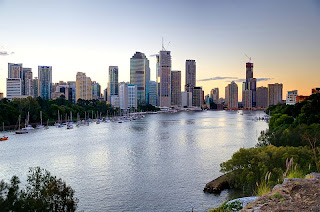2030 - 2012 = 18
2012 - 18 = 1996....ish
Please note that Brisbane’s rate of growth of 1.3% compounded and in 18 years a greater growth will be seen, especially with greater technology (ABS 2008).
Historically, Brisbane has continually developed further outwards, due to the accessibility granted from a car. The city has seen much change:
- Implementation and removal of trams 1969 (Wenham and Chalmers 2007)
- Pedestrianising Albert/Queen Street from 1982 - 1988 (Feeney, K. 2012)
- As well major high-rise development constantly ongoing.
Brisbane from Kangaroo Cliffs 1987. http://www.skyscrapercity.com/showthread.php?t=804970&page=2
Brisbane from Southbank 1996. http://kazza.id.au/MT-4.01-en/mt-search.cgi?tag=Scanning&blog_id=1
Brisbane from Southbank 2010. http://kazza.id.au/MT-4.01-en/mt-search.cgi?tag=Scanning&blog_id=1
Conclusion
Brisbane's population will continue to rise and so will its infrastructure requirements.
Parcels of land within the city will become either refurbished or redeveloped.
References
ABS. 2008. Population Projections, Australia, 2006 to 2101 . www.abs.gov.au/Ausstats/abs@.nsf/mf/3222.0. Accessed 19 September 2012
Feeney, K. 2012. Queen Street Mall's 30-year evolution. http://www.brisbanetimes.com.au/business/queen-street-malls-30year-evolution-20120227-1tyoq.html. Accessed 19 September 2012
Wenham, M., Chalmers, E. 2007. Trams Back in Brisbane. http://www.couriermail.com.au/news/queensland/trams-back-in-brisbane/story-e6freoof-1111113964875
Accessed 19 September 2012
Wenham, M., Chalmers, E. 2007. Trams Back in Brisbane. http://www.couriermail.com.au/news/queensland/trams-back-in-brisbane/story-e6freoof-1111113964875
Accessed 19 September 2012







No comments:
Post a Comment